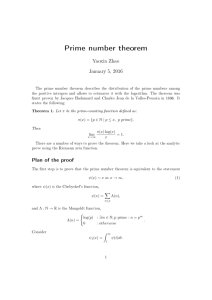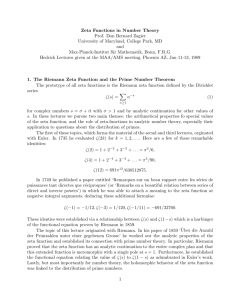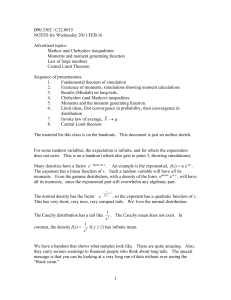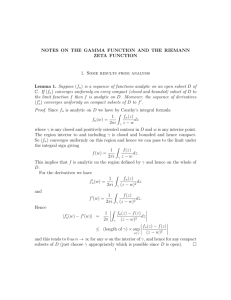Notes on the Riemann Zeta Function
advertisement
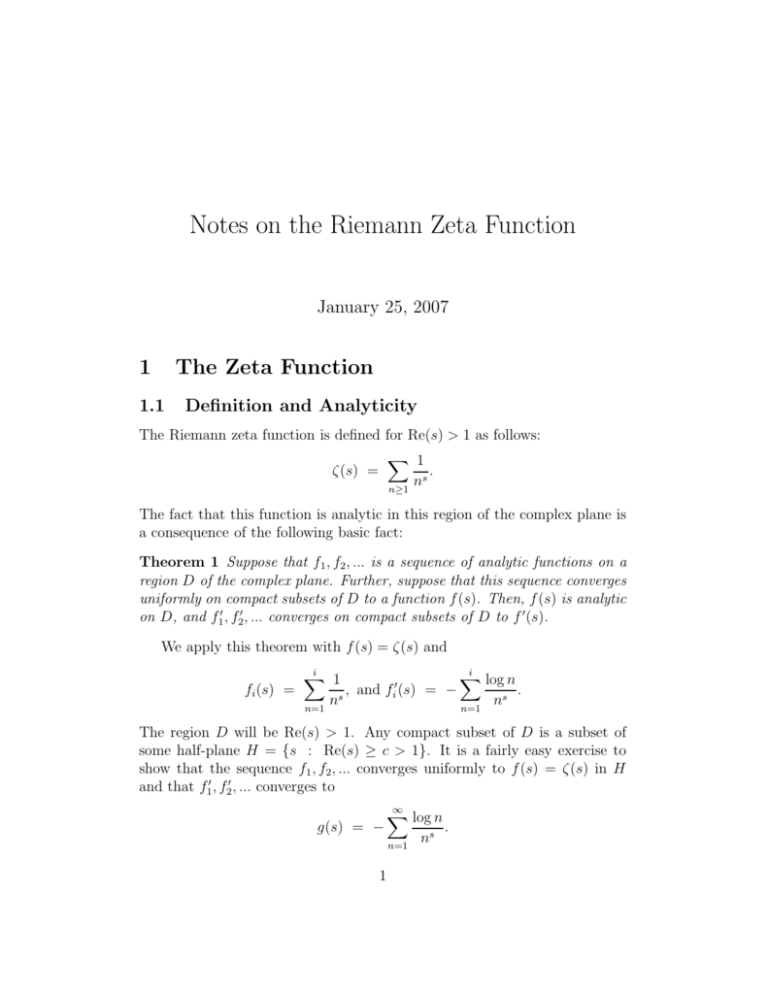
Notes on the Riemann Zeta Function
January 25, 2007
1
The Zeta Function
1.1
Definition and Analyticity
The Riemann zeta function is defined for Re(s) > 1 as follows:
X 1
.
ζ(s) =
s
n
n≥1
The fact that this function is analytic in this region of the complex plane is
a consequence of the following basic fact:
Theorem 1 Suppose that f1 , f2 , ... is a sequence of analytic functions on a
region D of the complex plane. Further, suppose that this sequence converges
uniformly on compact subsets of D to a function f (s). Then, f (s) is analytic
on D, and f10 , f20 , ... converges on compact subsets of D to f 0 (s).
We apply this theorem with f (s) = ζ(s) and
i
i
X
X
log n
1
0
, and fi (s) = −
.
fi (s) =
s
n
ns
n=1
n=1
The region D will be Re(s) > 1. Any compact subset of D is a subset of
some half-plane H = {s : Re(s) ≥ c > 1}. It is a fairly easy exercise to
show that the sequence f1 , f2 , ... converges uniformly to f (s) = ζ(s) in H
and that f10 , f20 , ... converges to
g(s) = −
1
∞
X
log n
n=1
ns
.
So, by the above theorem, it follows that for Re(s) > 1,
0
ζ (s) = −
∞
X
log n
n=1
ns
;
that is to say, we can get ζ 0 (s) by differentiating the formula above for ζ(s)
term-by-term when Re(s) > 1.
1.2
The Euler Product
As is well known, there is an intimate connection between the zeta function and prime numbers. This connection comes from the Euler product
representation for the zeta function given as follows:
−1
Y Y 1
1
1
.
(1)
1− s
1 + s + 2s + · · · =
ζ(s) =
p
p
p
p prime
p prime
The fact that this infinite product converges is a consequence of the following
basic theorem:
Theorem 2 Suppose that a1 , a2 , ... is a sequence of complex numbers, none
of which are −1, such that sn = a1 + · · · + an converges absolutely. Then, the
infinite product
∞
Y
(1 + ai )
i=1
converges.
1
Applying this theorem to our problem, we find that the above infinite
product over primes converges, provided
X 1
1
+ 2s + · · ·
(2)
s
p
p
p prime
converges absolutely. Letting s = σ + it, we have that
!
1
1
1
1
1
1
+
< σ
.
ps p2s + · · · ≤ pσ 1 − 1
p 1 − 21σ
pσ
1
The condition that none of the ai s be −1 is because in the usual definition of converging
infinite products, we don’t allow it to ‘converge’ to 0.
2
So, the sum on the left-hand-side of (2) converges absolutely and is bounded
from above in absolute value by
X 1
1
1 X 1
<
,
1 − 21σ p prime pσ
1 − 21σ n≥1 nσ
which converges for all σ > 1.
We are left to show that the value of the Euler product is actually ζ(s).
This is a consequence of the fundamental theorem of arithemetic, which says
that for every integer n ≥ 1, there is a unique sequence of non-negative
integers a2 , a3 , a5 , a7 , ..., one for each prime, such that
n = 2 a2 3 a3 5 a5 7 a7 · · ·
Note that all but a finite number of these ai ’s are zero. Now consider
Y 1
1
1 + s + 2s + · · · .
p
p
p prime
(3)
p≤n
Expanding this finite product out into a sum, we get a sum of a bunch of
terms of the form
c
,
2 a2 3 a3 · · · q aq
where q is the largest prime less than or equal n. By the fundamental theorem
of arithmetic, each such term must have c = 1. Also by the fundamental
theorem, we must have that the product (3), written as a sum, must include
the terms 1 + 1/2s + 1/3s + 1/4s + · · · + 1/ns . So,
∞
−1
X
Y
X 1 1
1
.
0 < −
1− s
(4)
<
js s
j
p
p
prime
j=1
j>n
p≤n
Letting n tend to infinity, the right hand side of (4) converges to 0. So, by
the squeeze law of limits, we conclude that (1) holds.
Note that this also tells us that ζ(s) 6= 0 for Re(s) > 1, because by the
definition of a converging infinite product that product does not ‘converge’
to 0.
3
1.3
A Basic Meromorphic Continuation to Re(s) > 0
We might try to analytically continue ζ(s) to a larger region, and there are
several things we might try to do this. It turns out that there is a rather nice
trick for doing this, at least if we want to get ζ(s) for Re(s) > 0. The idea is
to observe that for Re(s) > 1
∞
∞
∞
X
X
X
2
1
2
(−1)n+1
1 − s ζ(s) =
−
=
.
2
ns n=1 (2n)s
ns
n=1
n=1
Thus,
ζ(s) =
1−2
1−s −1
∞
X
(−1)n
n=1
ns
.
Now, one can show that the infinite sum here converges conditionally so
long as Re(s) > 0; moreover, its derivative converges conditionally in the
same region.
Notice however that the factor (1 − 21−s )−1 has a singularity at s = 1,
and in fact at s = 1 + 2πik/ log(2), where k ∈ Z. These poles are all simple.
Thus,
∞
X
(−1)n
1−s −1
(1 − 2 )
ns
n=1
is an analytic function in Re(s) > 0, except possibly at the points s =
1 + 2πik/ log(2), where k ∈ Z
Actually, it turns out to be the case that the only singuliarity (not counting removable singularities) is at s = 1. To see this, we produce another
analytic continuation of ζ(s) similar to the one above: We have that
3
1
2
1
1
2
1 − s ζ(s) = 1 + s − s + s + s − s + · · ·
3
2
3
4
5
6
for Re(s) > 1. Now, the sum
∞
X
δ(n)
n=1
ns
, where δ(n) =
1,
−2,
ifn ≡ 1, 2 (mod 3);
if n ≡ 0 (mod 3).
converges conditionally for Re(s) > 0. Thus,
1
2
1−s −1
(1 − 3 )
1+ s − s +···
2
3
4
is analytic in Re(s) > 0, except possibly at s = 1 + 2πik/ log(3). So, ζ(s)
is analytic in this region, except possibly at the interesection of the sets
{1 + 2πik/ log 3 : k ∈ Z} and {1 + 2πik/ log 2 : k ∈ Z}; that is, ζ(s) is
analytic in Re(s) > 0, except possibly at s = 1.
It follows that (s−1)ζ(s) can be analytically continued to all of Re(s) > 0
(where at s = 1 it has a removable singularity).
Note also that from this continuation we deduce that in the region Re(s) >
0, s 6= 1, ζ(s) = ζ(s). In particular, this says that if s = σ + it is a root of
ζ(s), then s = σ − it is also a root.
1.4
Another Continuation
Another way to continue ζ(s) is to observe that for Re(s) > 1,
Z ∞
d[x]
ζ(s) =
,
s
1− x
where the integral here is a Stieltjes integral. 2 Thus, integrating by parts,
we find that
∞
Z ∞
Z ∞
Z ∞
[x]dx
dx
{x}dx
[x] = s
−s
,
ζ(s) = s + s
s+1
s
x 1−
x
xs+1
1− x
1
1
where {x} = x − [x], which is the fractional part of x. So,
∞
Z ∞
{x}dx
sx−s+1 −s
ζ(s) =
.
1−s 1
xs+1
1
For Re(s) > 0 we therefore have that
s
= −s
ζ(s) −
s−1
Z
∞
1
{x}dx
.
xs+1
Notice that the integral on the right hand side here converges to an analytic function for all Re(s) > 0. This then gives and analytic continuation of
f (s) = ζ(s) − s/(s − 1) to Re(s) > 0 (with removable singularity at s = 1).
2
The 0 < < 1 here can be taken arbitrarily small. We need this in order to pick up
a jump discontinuity for [x] from [1 − ] = 0 to [1] = 1.
5
This therefore tells us not only that ζ(s) has a simple pole at s = 1, but it
also tells us its residue at s = 1:
Ress=1 ζ(s) = Ress=1
s
= 1.
s−1
This completes our discussion of some of the basic properties of the zeta
function.
2
The Functional Equation
2.1
The Mellin Transform
The Mellin transform is a basic integral transform whose main claim to fame
is that it helps to transform the symmetries of θ functions to symmetries of
ζ functions. It is defined as follows:
Z ∞
M (f )(s) =
f (t)ts−1 dt.
0
It sends a function f defined on the reals to a function M (f ) which is analytic
in some domain of the complex plane.
2.2
Facts about the Theta Function
The theta function is defined to be
θ(s) =
∞
X
e−n
2 πs
,
n=−∞
which is analytic on the right half plane Re(s) > 0.
remarkable functional relation
3
It also satisfies the
θ(s−1 ) = s1/2 θ(s).
(5)
2
3
2
Actually, one often defines the theta function with e2πin s , instead of e−n πs as I have
written it. These two versions of θ(s) are the same after an appropriate change of variables;
and, in the usual version, we get convergence of the series in the upper half plane, instead
of the right half plane in my version.
6
2.3
The Mellin Transform of w(s)
We don’t actually take the Mellin transform of θ(s), but instead take the
transform of the related function
X
θ(s) − 1
2
.
(6)
w(s) =
e−πn s =
2
n≥1
From the functional equation of θ(s) given in (5), we deduce that for real
s > 0,
2w(1/s) = θ(1/s) − 1 = s1/2 θ(s) − 1 = 2s1/2 w(s) + s1/2 − 1.
(7)
Put another way,
w(s) = s−1/2 w(1/s) −
1 s−1/2
+
.
2
2
Now, then,
M (w) =
Z
∞
w(t)t
s−1
dt =
0
XZ
n≥1
∞
2
e−πn t ts−1 dt,
(8)
0
provided Re(s) > 1/2. Convergence of this first integral is guaranteed because from the functional from (6) we have that for t near 0, w(1/t) ∼ 0,
and therefore from (7),
w(t) ∼ t−1/2 /2.
Thus, w(t)ts−1 ∼ ts−3/2 /2 near t = 0. The integral from, say, 0 to 1 of this
function therefore converges if Re(s) > 1/2. Also, the integral, say, from
t = 1 to ∞ of w(t)ts−1 will be bounded, because near infinity w(t) ∼ e−πt ,
which decays very rapidly.
The integration of w(t)ts−1 in (8) term-by-term is justified because of the
rapid convergence of
X
2
e−πn t
n≤N
to w(t) (that is, letting N → ∞).
Now, a typical term in infinite series in (8) is
Z ∞
Z ∞
Γ(s)
1
s−1 −πn2 t
ts−1 e−t dt = s 2s ,
t e
dt = s 2s
π n
π n
0
0
7
where Γ(s) is the usual gamma function.
Thus,
M (w)(s) = π −s Γ(s)ζ(2s),
(9)
for Re(s) > 1/2.
On the other hand, M (w)(s) inherits a certain symmetry from the functional equation (7). To see what this symmetry is, we need a trick. The trick
is to break the first integral in (8) up into two pieces, one over t ∈ (0, 1) and
the other over t ∈ (1, ∞); and then,
Z ∞
Z 1
s−1
w(t)ts−1 dt
w(t)t dt +
M (w) =
1
0
Z 1
1 t−1/2
−1/2
s−1
=
t
w(1/t) − +
t
dt
2
2
0
Z ∞
+
w(t)ts−1 dt.
(10)
1
Letting u = 1/t, we have that this integral going from t = 0 to t = 1
becomes
Z ∞
Z ∞
1
1
1 u1/2
−1−s
1/2
−
du =
u−1/2−s w(u)du −
u
u w(u) − +
2
2
2s 1 − 2s
1
1
So,
M (w)(s) =
Z
∞
1
1
1
w(t) t−1/2−s + ts−1 dt −
−
.
2s 2(1/2 − s)
(11)
So, if we make the transformation s → 1/2 − s, we observe that M (w)(s)
remains unchanged; in other words,
M (w)(s) = M (w)(1/2 − s).
Also, observe that
M (w)(s) +
1
1
+
2s 2(1/2 − s)
(12)
is holomorphic, because the integral in (11) is converges for all s. This follows
from the bound that for t ≥ 1,
X
w(t) <
e−πnt < 2e−πt .
n≥1
8
So, M (w)(s) is meromorphic with simple poles at s = 0 and s = 1/2.
From (12) and (9) we deduce an analytic (meromorphic) continuation of
ζ(s) to the whole complex plane:
π −s Γ(s)ζ(2s) = π s−1/2 Γ(1/2 − s)ζ(1 − 2s), except at s = 0, 1/2.
In other words,
π −s/2 Γ(s/2)ζ(s) = π −(1−s)/2 Γ((1 − s)/2)ζ(1 − s),
except at s = 0, 1.
This gives us an analytic (meromorphic) continuation of ζ(s) to the whole
complex plane. The only singularity is at s = 1. There are zeros of ζ(s) when
Re(s) < 0 corresponding to the poles of Γ(s/2): We have that for any positive
integer n that
lim ζ(−2n) = π −1+2n Γ((1 + 2n)/2)ζ(2n + 1) lim Γ(s/2)−1 = 0.
s→−2n
s→−2n
Also note that it makes sense to define the holomorphic function
ξ(s) =
s(1 − s) −1/2s
π
Γ(s/2)ζ(s).
2
This function satisfies
ξ(s) = ξ(1 − s).
2.4
Zeros of the Zeta Function, and the Riemann Hypothesis
As we have said, ζ(s) has zeros at the negative even integers, and these are
the only such zeros for Re(s) < 0. Also, for Re(s) > 1, ζ(s) has no zeros.
This leaves the region 0 ≤ Re(s) ≤ 1, which is called the “critical strip”.
It turns out that ζ(s) has no zeros on the lines Re(s) = 0 or 1. And, we
already know that if s is a root, then s is also a root. The functional equation
gives us an additional symmetry, namely that if s is a root, so is 1 − s.
The famous Riemann Hypothesis asserts that in the critical strip all the
roots of ζ(s) lie on the line Re(s) = 1/2. The truth (or falsity) of this
conjecture would have profound consequences concerning the distribution of
prime numbers.
9
3
The Connection with Prime Numbers
It turns out that there is a formula, called the “explicit formula” which relates
the zeros of ζ(s) to the distribution of prime numbers. We will not bother
to prove this formula here. To describe the formula, we first define the von
Mangoldt function Λ(n), which is
log p, if n = pa , p prime;
Λ(n) =
0, otherwise.
So, Λ(n) is a certain funny weighting on the prime numbers. It is an easy
exercise to prove that
X
log(lcm(1, 2, 3, 4, ..., n)) =
Λ(m).
m≤n
It also turns out that for Re(s) > 1, the logarithmic derivative of the zeta
function is
∞
X
ζ 0 (s)
Λ(n)
−
=
.
ζ(s)
ns
n=1
The explicit formula says that
X
n≤x
Λ(n) = x −
X xρ ζ 0 (0) 1
−
− log(1 − x−2 ).
ρ
ζ(0)
2
ρ:ζ(ρ)=0
Re(ρ)>0
Actually, this is not quite right: It is true provided that x is not an integer;
when x is an integer, the term Λ(x) of the above sum should be Λ(x)/2 – all
other terms are correct.
It turns out that there is a finite version of this formula, where we trucate
the sum over zeros to those where |Im(ρ)| < T . This formula is
X
n≤x
Λ(n) = x −
X
|Im(ρ)|<T
xρ ζ 0 (0) 1
−
− log(1 − x−2 ) + R(x, T ),
ρ
ζ(0)
2
where
(13)
x log2 (xT )
x
+ (log x) min 1,
,
T
T <x>
where C > 0 is some constant, and where < x > denote the distance from x
to the nearest prime power.
|R(x, T )| < C
10
It is also known how many terms there are in the sum over zeros in (13).
The number of such zeros is
T
T
T
log
N (T ) =
− + O(log T ).
π
2π
π
So, if the Riemann Hypothesis were true we could deduce that
X
Λ(n) = x + O(x1/2 log2 x)
(14)
n≤x
√
by taking T = x.
It is realatively easy to show that this implies
π(x) = Li(x) + O(x1/2 log x),
where
Li(x) =
Z
∞
2
dt
x
∼
,
log t
log x
where π(x) is the number of primes ≤ x.
Conversely, one can show that if the primes are distributed according to
(14), then the Riemann hypothesis is true.
11






